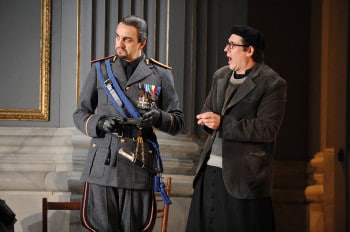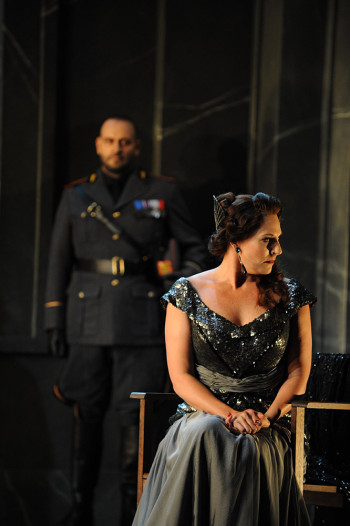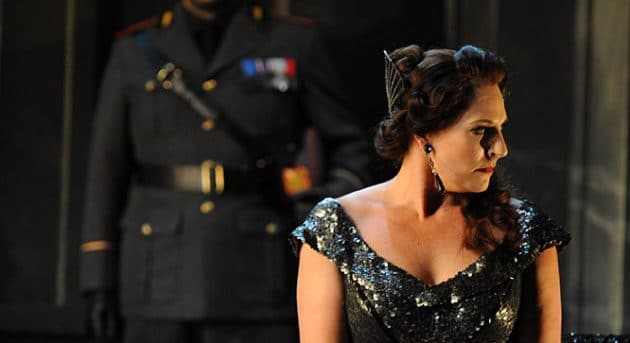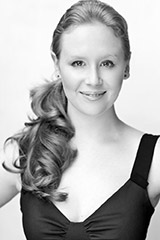Opera Australia’s Tosca – Sydney Return Season
John Bell’s stark, powerful production of a Puccini classic

Photo credit Branco Gaica.
Although Tosca was initially slammed by critics upon its premiere, the opera still stands as one of Puccini’s greatest musical achievements and one of the most spectacular operatic works in the canon. John Bell’s understated and powerful take on this classic reminds us how potent operatic stories can be when told truthfully.
This production was initially staged in 2013 and it bears a second viewing. The story unfolds in fascist Italy in 1943, at the beginning of the Nazi occupation of Rome. It’s a clever reading of the opera, highlighting themes of heroism, morality, power and its abuse.
There is a striking simplicity to Bell’s production: in the sparse and monumental sets, the sensitive direction and the compelling and naturalistic performances Bell draws from the three leads. Bell makes it easy for us to recognize ourselves on stage; in Cavaradossi’s heroism, Tosca’s devotion and Scarpia’s violence. He eschews the typical melodrama for truthful acting and this is one of the production’s greatest strengths.
Bell said he wanted to consider the “banality of everyday evil” in this work, and he has done this in the way he presents violence as an everyday act. We see this when Baron Scarpia casually molests a female secretary during a meeting with his officers, and no one appears concerned, or at the end of the First Act, when Nazi soldiers invade the church and the chorus unites with their first Nazi salute.
Set designer Michael Scott Mitchell has created three distinct and spectacular sets for each Act. The striking Roman cathedral of the First Act, Scarpia’s military chambers and the austere Castel Sant’Angelo of the Third Act all utilize the space in clever and dynamic ways and allow for Nazi symbolism to be subtly inserted into each set.
Musically, this is Puccini at his best. The score is filmic and sweeping, and young conductor Andrea Battistoni leads the orchestra with a highly energized and sensitive reading of the score, elegantly supporting the singers where needed.
In the title role, South African soprano Amanda Echalaz is formidable. Her dramatic soprano is beautifully even, with a seemingly endless supply of powerful top notes and rich golden lower registers. Her Vissi d’arte was a study in understated, devastating stillness. Her Tosca is full of contradictions – frail and vulnerable one minute, fierce freedom fighter the next – making her immensely likeable from the outset.

Photo credit Branco Gaica.
In the title role, South African soprano Amanda Echalaz is formidable. Her voice is stunningly even throughout it’s range, with a seemingly endless supply of powerful top notes and rich golden lower registers. Her Vissi d’arte was a study in understated, devastating stillness. Her Tosca is full of contradictions – frail and vulnerable one minute, fierce freedom fighter the next – making her immensely likeable from the outset.
And she shares palpable chemistry with romantic lead Cavaradossi, sung by young Italian tenor Ricardo Massi. His warm, lighter tenor may not be as full as other singers who have tackled the role, but he sings with warmth, security and a stunning legato line. He brings an easygoing charm to the role of artist, fighter and lover, but if anything was perhaps too laidback, particularly in the First Act.
As Scarpia, the executioner, Italian baritone Claudio Scura is just so good at being bad. It’s a dark and subtle portrayal, with an underlying malevolence that pervades the whole opera. His dark baritone is richly expressive and he sings with great sensitivity. Scura makes him suavely menacing almost to the point of seduction, but it’s clear he’s a character who relishes in other people’s suffering. Scarpia’s entourage of grisly henchmen are equally menacing and impeccably acted by the OA chorus.
Strong support comes from David Parkin as the impassioned escapee Angelotti, and Luke Gabbedy, in a semi-comic cameo as the scuffling Sacristan. The OA chorus and boy’s choir are in fine form also.
For powerful storytelling and a production that makes this opera instantly relatable, Tosca is well worth your time.



